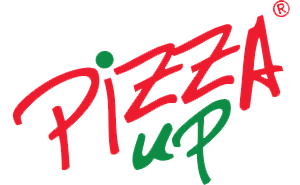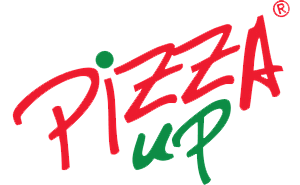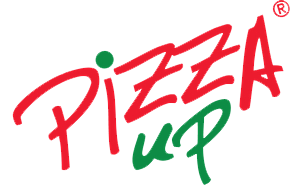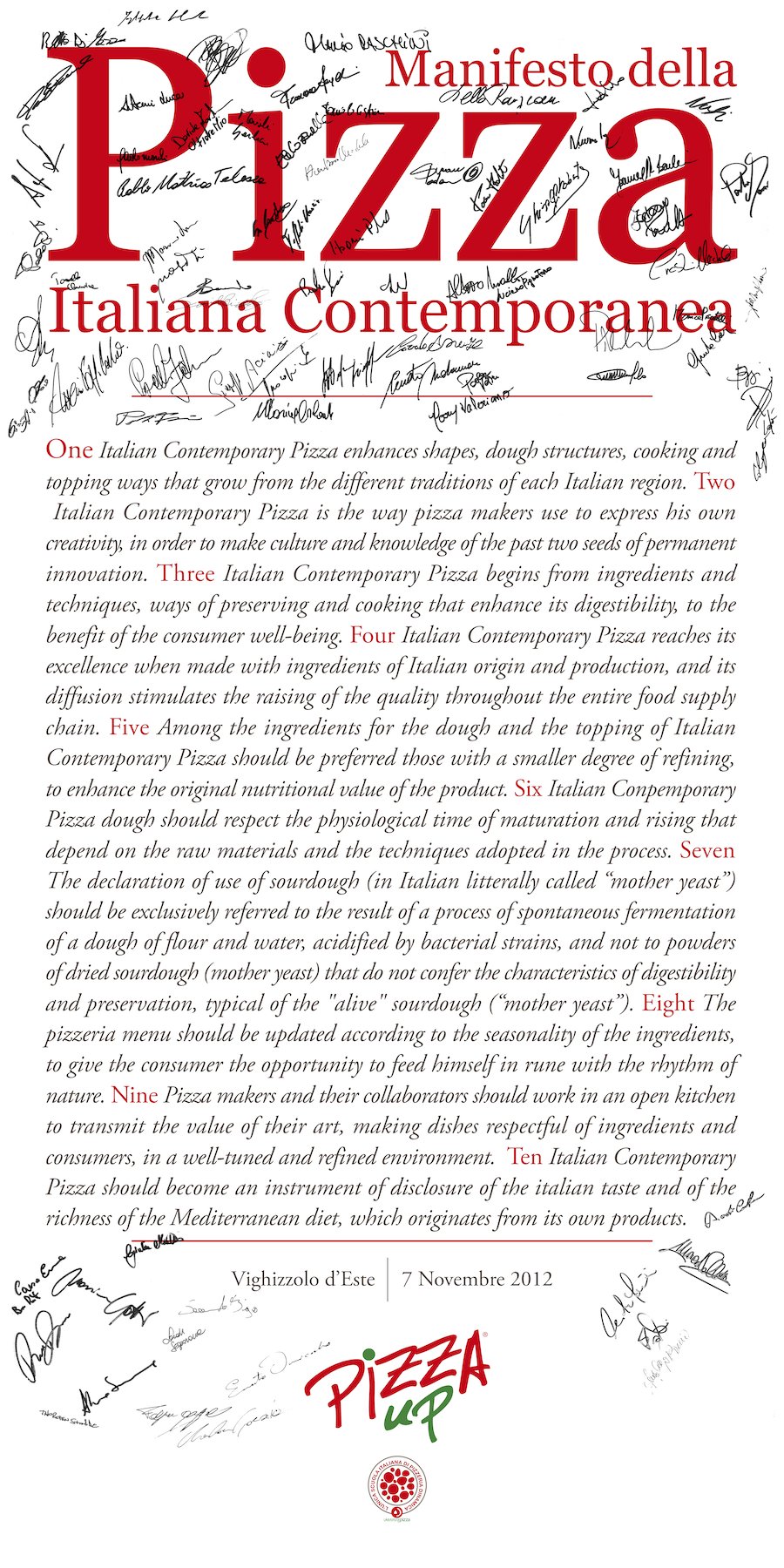PETRA srl - via Roma 49 - 35040 Vighizzolo d'Este (PD) Italia IT03968430284
PETRA srl - Vighizzolo d'Este (PD) IT03968430284
PETRA srl - IT03968430284
PETRA srl - via Roma 49 - 35040 Vighizzolo d'Este (PD) Italia IT03968430284
PETRA srl - Vighizzolo d'Este (PD) IT03968430284
PETRA srl - IT03968430284



PizzaUp is the only technical symposium on contemporary Italian pizza.This year’s 13th edition will be, as usual, the vanguard stage to outline new experience paths on this iconic Italian dish. PizzaUp brings together contemporary pizza makers from all over Italy and offers them the opportunity to exchange ideas among them and with the representatives of the press and the world of culture on topics with technical and social repercussions. This year the focus is on the relation between farm culture, spontaneous fermentations and gastronomic diversity to identify a key to understand dietary models that are constantly changing.
Participation in PizzaUp is exclusively reserved to professional pizza makers.
Antico Molino Quaglia
via Roma 49
Vighizzolo d'Este (PD)
5, 6 e 7
November 2018
You may not need new ideas now for your habitual customers. But what about if a new idea could attract new customers? PizzaUp has been a source of new ideas since its first edition because the topic of every edition is the result of an insight on how consumers’ tastes evolve. Following seminars and practical workshops during the symposium means opening up to new horizons of the kind of pizzerias that become more and more similar to restaurants, including in their most traditional features.
Have you ever heard that to learn a craft well you should “steal the art” from those with the best techniques? PizzaUp is the best environment where “to mutually steal” the techniques of a craft that needs to renew rather than to live off nostalgic and imaginative references to old fashioned and anachronistic “traditions”. The time of the pizza makers who enhance their skills leveraging the valuable work carried out by those who started their family tradition is over. What is needed today is food culture and knowledge of the right techniques to work with fresh ingredients, to properly control the fermentation of doughs and the different cooking times of pizza base and toppings.
Young and not so young share their habitual and continuous use of modern communication tools, with a speed for finding information that is unprecedented in human history. The difference compared to just 5 years ago is that radio, newspapers, television, telephones, guides, maps, mail and product showcases live all in the same device and this device is in our pocket. Our constant companion, the mobile phone, is a door that we leave open to receive news on the latest things in real time and, with that, we also received the reviews of those who had experienced them. These comments are made up of photos, videos, words, positive or negative feedbacks, and are the modern “word of mouth” used to convey the value of one’s pizzeria. To attract new customers it is necessary to network with other pizza makers and players of the food chain to strengthen communication and reach large numbers of readers at accessible costs.
Participation in PizzaUp is exclusively reserved to professional pizza makers.
The thirteenth edition of PizzaUp 2018 will take place from 5 to 7 November 2018. This year’s formula has been completely revisited compared to the previous twelve editions. The topic will be far-reaching: interactions between climatic conditions and growing techniques for cereals, milling techniques, changes due to dough fermentations, as well as a more comprehensive vision of how pizza interprets the benefits of the Mediterranean Diet through its local expressions.
The rediscovered correct interpretation of the value of carbohydrates in the Mediterranean Diet has been one of our intentions for a long time, so much so that in 2012 we promoted the Italian Contemporary Pizza Manifesto that was later formulated and underwritten by some of the most important Italian food and wine experts. Since then, every edition of PizzaUp (as at today the only technical symposium of Italian pizza) has seen the presence of representatives of universities, journalists, bloggers, chefs, communication, architecture and marketing experts, columnists and science popularisers. And the pizza makers in attendance have been involved in stimulating theoretical and practical sessions, rich in new ideas, aimed at serving pizza in accordance with the Mediterranean Diet. .
The records of PizzaUp 2013, contain a comment of Eleonora Cozzella (from La Repubblica newspaper) about a proposal made in that symposium of a recipe for a traditional Neapolitan pizza with 180g dough: “The intention is developing a new way of making pizza with a focus on health. Starting from the food pyramid of the Mediterranean Diet. At the basis of which there are wholegrain cereals”. Today, five years later, great progress has been made in all pizza sectors and the recent news that a professional pizza maker like Franco Pepe is working on the basis of the Manifesto, focusing specifically on the nutritional profile and reduction of the pizza base weight, is further evidence of the value and topicality of the activities of PizzaUp of 2012 and 2013.
The relationship between table and climate is closer and closer because natural cuisine must follow the seasons, taking into account that the varying quality of ingredients is not a fault, but an aspect to be enhanced using the right techniques. Farmers, researchers and chefs will talk about the land starting from the seed and showing how informed dietary choices can be made only with transparent food chains.
Fermentation processes were common food preservation methods before refrigerators. Today, knowing how to control a fermentation process means opening new taste, structure and nutritional approaches. Let’s just think of the ability of living sour dough to enrich the sensory experience of pizza: it boosts the aromas of other ingredients, it reduces the glycaemic peak and the inflammatory characteristics of gluten. Furthermore, there is the fermentation of vegetables.
Unlike some years ago, today it is difficult to think of a pizza made without knowing cooking techniques that respect the ingredients. Temperature control, diversified cooking times, cutting and pan frying of vegetables, preparation of meat and fish: these are some examples of the techniques that must necessarily be part of the know-how of a contemporary pizza maker. Consumers change tastes adopting different dietary styles, so pizza must be proposed to correctly interpret these varying requests.
in ordine di apparizione e alfabetico
Laurea in Tecnologie alimentari e poi la necessità di mettere le mani in pasta per esprimere in pieno la sua sensibilità e inclinazione a comunicare. Così il suo percorso prosegue con un master in Alma nel quale completa la sua formazione con elementi di economia e di tecnica gastronomica. Poi una stage nel laboratorio del Molino Quaglia, un’esperienza concreta nella squadra del Grigoris di Mestre (una pizzeria dal deciso taglio contemporaneo) e, infine, il ritorno al Molino Quaglia che gli affida nel 2015 la direzione del Mamapetra (nel Mercato Metropolitano di Porta Genova),una bakery d’avanguardia costruita per Expo attorno ad un cubo di vetro con controllo climatico e cromatico per far lievitare il pane naturalmente in un ambiente di impasto isolato da fattori esterni. Oggi partecipa con Giulia Miatto alle attività di ricerca della Scuola del Molino Quaglia e tiene corsi e sessioni tecniche su impasti e lieviti in Italia ed all’estero.
Laurea in economia e poi la scelta di cambiare strada spinta dalla passione per la pasticceria. Dopo esperienze di studio e lavoro in questo settore della cucina, approda a Molino Quaglia dove entra a fare parte del gruppo di lavoro di Università della Pizza, maturando esperienze significative nello sviluppo di nuovi modelli di impasti e lieviti naturali. Oggi è responsabile didattica dei corsi della Scuola del Molino Quaglia e docente nei corsi che illustrano il risultato della sua ricerca. Partecipa inoltre in qualità di relatore a eventi gastronomici e sessioni pratiche di esperienza con gli impasti. Nell’edizione 2016 di Identità golose presenta sul palco la “Linea del Pane”, un metodo innovativo per realizzare le più comuni strutture del pane (pagnotta, ciabatta, focaccia salata,panino morbido, grissino e cracker) utilizzando un solo impasto con lievito naturale.
“Il lavoro che faccio adesso – ha esordito Ceccarelli – è frutto di un lungo percorso scientifico iniziato in modo formale in Italia e proseguito in studi di ricerca internazionale in Siria fino alla fine degli anni ’90. In quel periodo mi sono reso conto che la ricerca legata al ‘miglioramento genetico‘ fatta nelle stazioni sperimentali – e quindi in qualche modo artificiali – diventava sempre meno rappresentativa della realtà agricola; ho quindi cominciato a pensare che si sarebbero ottenuti risultati migliori spostando la ricerca direttamente nei campi dei contadini, mantenendo – ovviamente – lo stesso… (Testo e foto estratti da Italia che cambia )
“In un campo di grano moderno – dice Li Rosi – , dove viene applicata la chimica di sintesi, tutte le spighe sono tutte una clone dell’altro perché si tende all’omogeneità e allo standard. Noi, invece, ci ispiriamo al campo evolutivo/partecipativo, quello che, grazie allo scienziato Salvatore Ceccarelli, presidente del nostro comitato tecnico scientifico, stiamo sperimentando già da 4 anni. Nei nostri campi facciamo miscugli di migliaia di… (Testo e foto estratti da Wise Society )
Un aggettivo che può dire tutto o niente, e però per il percorso (anche di vita) che Boer ha tracciato sin qui probabilmente vuole farsi carico di quella “irrequietezza” di cui sopra, sistematizzando un bel numero di influenze, suggestioni, aspirazioni, al servizio dell'indubbio talento di Eugenio. Sarà quindi, ancora una volta, una cucina di gusto e complessità, con una novità evidente nell'approccio al cliente, chiamato a scegliere non da una carta di piatti, ma da un bouquet di concetti di degustazione, che pescano nel passato dello chef e ne rappresentano il futuro che vuole disegnare davanti a sé. Nulla di esoterico a ben guardare, perché … (Testo e foto estratti da Gambero Rosso)
Mattei è uno chef di talento nel pieno della maturità, che sfrutta il paradiso d'ambiente in cui si è stabilito per tratteggiare una delle cucine locali più interessanti dell'Italia contemporanea. Niente reinterpretazioni scontate, un taglio personale per raccontare il cuore della Toscana senza proibirsi a priori qualche inserto di mondo esterno. Nascono così piatti che non assomigliano a nulla di già assaggiato, come il … (Testo estratto da Repubblica Sapori)
Da Niko Romito mi sono formato, sono stato con lui sette anni, i primi della mia carriera, quelli fondamentali. Nino Di Costanzo mi ha insegnato ad essere rigoroso, preciso ed organizzato. Gennaro Esposito per me ha rappresentato l’espressione della praticità, della concretezza e della schiettezza, sia nella vita, sia per ciò che concerne i sapori. Mauro Uliassi mi ha regalato un pizzico di estrosità, quella che non guasta mai, soprattutto nel nostro lavoro. Valeria Piccini mi ha preso per mano sottolinenando l’importanza dei valori, del gruppo e della famiglia intesa dal punto di vista professionale, di lei posso dire che è stata la mia “mamma in cucina” (Testo e foto estratti da Sole 24 Ore )
Oggi, a poco più di un secolo, in cima all'altopiano dei Sette Comuni si è stanziato un ragazzo placido e sensibile che si chiama Alessandro Dal Degan, mosso dall'ambizione un po' folle di ridisegnare la cucina locale a partire dalle tracce storiche che ha potuto mettere insieme. È tornato indietro fino ai Cimbri e ha letto di una … (Testo e foto estratti da Repubblica Sapori )
Cosa ci fa un giovane cuoco sardo, dal curriculum stellare, in compagnia di una compagna veneta sulle montagne del Bellunese? Semplicemente una cucina fuori dall’ordinario. Davvero, senza fronzoli e ammiccamenti effimeri, Oliver Piras e la sua dolce metà Alessandra Del Favero vivono e lavorano dal 25 giugno 2014 nel loro AGA Ristorante, all’interno dell’hotel Villa Trieste a San Vito di Cadore (BL).
Da Selargius in provincia di Cagliari, passando per le cucine di Joël Robuchon, Chicco e Bobo Cerea e Norbert Niederkofler, Oliver Piras giunge infine … (Testo e foto estratti da Italia Squisita)
Come si diviene lo chef straniero più stimato dai colleghi dell’alta ristorazione italiana? Chiedetelo a Wicky Priyan, chef e patron dell’omonimo ristorante Wicky’s di Milano che, con la sua Wicusine ha introdotto in Italia un concetto nuovo e unico di cucina che prende spunto fedelmente dalla tradizione giapponese, contaminandola con le migliori materie prime mediterranee, soprattutto di provenienza italiana. Originario dello Sry Lanka con un passato da criminologo, segue la passione per il viaggio e per l’arte culinaria che lo portano in Giappone, affiancando alcuni tra i più grandi … (Testo e foto estratti da Lorenzo Vinci)
Alcuni pasticcieri sostengono che questa disciplina non ha più nulla da aggiungere perché tutto è stato già detto, codificato. Un pensiero imposto dalle industrie dei macchinari e dei semilavorati. Che genera dolci che sembrano carrozzeria fresca, usciti dalle fabbriche di automobili. Per me è imbarazzante quanta importanza venga attribuita oggi alla geometria nella concezione di una torta. Ma un dolce deve avere un'anima, esibire anche strisce irregolari di salsa, l’eleganza anarchica di un pezzo di frutta. Le creazioni dei grandi … (Testo e foto estratti da Identità Golose Web)
«Quando hai della grande materia prima, diventa tutto molto più semplice». La fa facile Lionello Cera ma se a noi comuni mortali recapitassero gli stessi crostacei e le migliori verdure del mondo di cui dispone, il risultato non farebbe altrettanto sognare. Nemmeno con un piatto tecnicamente non così proibitivo come la Catalana di crostacei, un classico di mare forse nato nella regione attorno a Barcellona ma di fatto dilagante nel nostro paese, dalla Sardegna via via a tutto il Continente. La migliore che abbiamo mai assaggiato arriva da … (Testo estratto da Identità Golose Web)
The PizzaUp Programme proposes occasions to listen, to exchange ideas and to engage in team activities. The symposium approach therefore offers the possibility of exploring alternative ways to bring back to one’s daily work new ideas that can become a reality. This teamwork model has led to the birth in the last 10 years of a contemporary way of developing and sharing a pizza consumption experience that attracts a growing number of gourmet consumers.
NOTE
Participation in PizzaUp is exclusively reserved to professional pizza makers.
In parallel with the activities of PizzaUp 2018, 15 pizza makers will be interviewed, photographed and filmed live to enter the first
Who has been the first pizza maker in the last 25 years to bravely apply an innovative idea in the preparation of pizza dough? And the first to use fresh, in-season ingredients? Who has highlighted and enhanced the tie with farmers and land? Who has redefined the balance between water, flour and yeast to make doughs lighter? Who has been the first one to see and make a high-cuisine future for pizza?
There are people who combine thinking and passion for what they do, to make their vision of innovation real. Not to amaze or rank first, but to contribute to passing on values they received from the past. These people are the witnesses of what was and has been good and spontaneously dedicate their life to granting that goodness a future by creating original and contemporary products and consumption experiences. They therefore become models to copy, their charisma drives others to diversify the original ideal through new forms of expressions that enrich food culture.
The Year-book is dedicated to these pizza makers and to the ones who will come in the future to talk about their own moment of change that modified the world of pizza as well and prevented soulless copies to dim the originals.
The Pizza Year-book will be an annual publication characterised by a brand-new concept rich of photos, videos, recipes and new articles that will write the history of contemporary pizza year after year casting light on the work and creativity of “enlightened” pizza makers that become models to follow.
The purpose of the Pizza Year-book is to keep a time record of ideas, visions and developments in the field of contemporary pizza and associate it to the author who first introduced a specific innovation in terms of recipe, communication models and consumption experiences.
This non-sponsored work will self-fund through the sale of the book and will be a lasting acknowledgement of those who use their soul and passion to contribute to a healthier lifestyle through a natural, tasty and contemporary diet (i.e. tradition revisited in a modern way to pass down our local gastronomic traditions).
It will be the evolution of the Università della Pizza® project that was born from an original idea and that has grown year after year to educate and keep the bond between land, craft, techniques for dough preparation and development of recipes that must become elements of culture and not an extra line in the pizzeria menu.
Writing down how all this has happened and is happening day after day through characters of unique sensitivity and creativity is a necessity to prevent soulless copies from becoming more credible than the originals.
The Pizza Year-book will be published by FUORI (registered with the Court of Milan) and those who would like to read it can subscribe online or order a printed hardcover copy (at your expenses) to glance through the pages, show it to the public or keep it on one’s bookshelves
RIASSUNTO DELL' EDIZIONE PRECEDENTE
PIZZAUP® 2012
The official birth of "gourmet pizza"
The sixth edition of PizzaUp® (5/7 November 2012) ended with the drafting of the Italian Contemporary Pizza Manifesto: 10 ethical/professional principles for all pizza makers, to define what is meant by a tasty and healthy pizza, as well as affordable access to fine Italian cuisine.
The Manifesto of Italian Contemporary Pizza opened up a new road for high-end, creative pizzerias, and brought together for three days in Vighizzolo d'Este (Padua) a working group that included (in alphabetical order) Francesca Romana Barberini, Eleonora Cozzella, Piero Gabrieli, Elena Maccone, Renato Malaman, Paolo Marchi, Paolo Massobrio, Gianluca Mazzella, Davide Paolini, Luciano Pignataro, Monica Piscitelli and Chiara Quaglia.
The Manifesto, which came out of research and continuous dialogues with pizza makers throughout Italy carried out by Università della Pizza® over the previous 5 years, is the "live" result of an in-depth, spirited discussion and debate on the standards of a dish of Italian cuisine and tradition par excellence. It can make a vital contribution to the dissemination and knowledge of the great Italian ingredients, in addition to being a driver for the qualitative and quantitative development of the entire agri-food sector.
All thanks to the creativity of those pizza makers who give importance to the technical aspects of flour, yeast and ways of preparing and baking pizza, who choose the raw materials, from the wheat to the toppings, with a careful eye on easy digestibility and nutritional characteristics. Leggi di più.
